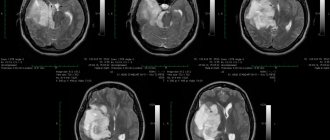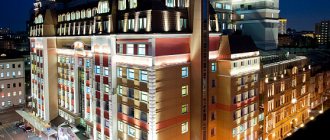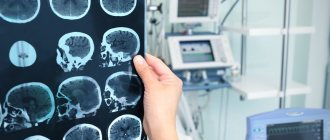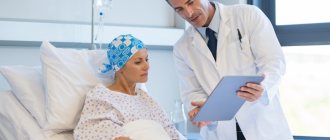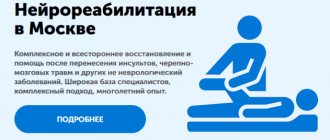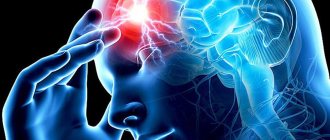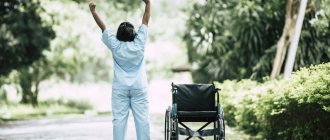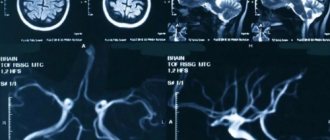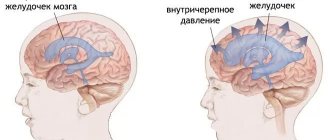In neurosurgical practice, brain tumors are divided into primary and secondary. Primary ones include those that are formed in brain tissue, nearby lymph nodes, cranial nerves, and blood vessels. Secondary (daughter) are the result of metastasis of cancer cells from other organs.
The choice of therapy depends on the histological type and location of the tumor. The main methods of treatment include scalpel or laser operations, chemotherapy and radiotherapy. Very often all these methods are combined with each other.
Surgical intervention
Brain surgery is a complex, time-consuming process, the consequences of which are unpredictable and determined by the location of the tumor. Any complications, such as bleeding, infections, damage to blood vessels and nerve fibers, swelling, can lead to negative cognitive and motor changes:
- paresis - loss of muscle strength with impaired coordination and gait, tremors of the limbs;
- apraxia - the inability to perform habitual or consistent movements necessary to carry out goal-directed tasks;
- agnosia – the inability to identify objects through the senses due to disorders of information perception: auditory, visual, gustatory, olfactory, tactile, spatial;
- hemianopsia – loss of visual fields;
- aphasia – complete or partial loss of speech;
- dysarthria – distorted and difficult pronunciation of certain sounds and words;
- alexia – difficulties in recognizing letters and understanding the meaning of what is read;
- agraphia – loss of writing skills, coordination of letters, prepositions, syllables, even with preserved intelligence;
- deterioration of memory, attention, thinking.
Mental dysfunction may also occur for another reason. During the period of tumor growth, the brain was subjected to compression of certain sections responsible for certain functions, to which it managed to adapt. But as a result of the removal of the neoplasm, the tissues find themselves in an unusual position for them, and this also becomes the basis for disruptions in cerebral activity.
Priority is given to the surgical method when the malignant tumor has clear boundaries. Contraindications for surgery are:
- multiple foci of the tumor process;
- severe chronic diseases in the acute stage;
- metastatic lesions of surrounding tissues;
- cachexia – extreme exhaustion.
Increasing headaches in the postoperative period are rare and should be reported to medical staff immediately, as they signal intracranial edema. In such a situation, drips with analgesics are prescribed and steroids are added.
Physiotherapy
The physiotherapy techniques used are well studied and have proven their effectiveness and safety for several decades. The same techniques are used for cancer patients in rehabilitation clinics in Switzerland, Germany, and Israel. The effectiveness of the methods is very high.
Advantages of physical factors:
a) Certain physical factors are approved for use in cancer patients around the world.
b) physical factors are elements of the natural environment and do not introduce anything foreign into the body.
c) physical factors have healing and normalizing effects and have a training effect when used prophylactically.
d) complete absence of allergization of the body and toxicity.
e) good compatibility with drugs. In some cases, physiotherapy potentiates and greatly enhances the effect of drugs.
e) have an aftereffect. A special feature of the effects of physiotherapeutic procedures is their long-term aftereffect: the long-term results of physiotherapeutic treatment are in most cases better than the immediate results.
g) treatment with physical factors does not cause pain or discomfort.
Applied therapeutic effects:
1) Low-frequency magnetic therapy
Therapeutic effects: immunomodulating;
hypotensive, caused by relaxation of the smooth muscle muscles of the vascular walls and the relief of spasms as a result of normalization of neurohumoral regulation; activation of tissue and vascular regeneration, including reparative osteogenesis; pain relief and improvement of psychophysical and emotional state, normalization of sleep; powerful anti-inflammatory and anti-edematous effect; improvement of microcirculation, peripheral blood flow and lymphatic drainage; stimulation of hematopoiesis; activation of links of the sympathoadrenal and hypothalamic-pituitary-adrenal systems. 2) Low-intensity laser therapy
Therapeutic effects: analgesic;
anti-inflammatory; regenerating (healing); decongestant; immuno-corrective; anti-sclerotic (reduces atherogenicity coefficient, reduces blood viscosity); antioxidant; desensitizing; antispasmodic; vegetative-correcting. 3) Electrotherapy
Therapeutic effects: anti-inflammatory (draining-dehydrating);
trophostimulating; anesthetic; sedative (at the anode); vasodilator; muscle relaxant; metabolic; secretory (at the cathode). 4) Ultrasound therapy, phonophoresis of drugs
Therapeutic effects: acceleration of regeneration and repair processes; restoration of nerve fiber conductivity in case of peripheral nerve injuries; resorption of infiltrates, traumatic edema, exudates and hemorrhages; anti-inflammatory (secondary effect); anesthetic; ganglionic blocking; antispasmodic; metabolic; hypotensive; desensitizing; fibrinolytic; defibrosating; bactericidal; increasing the adsorption properties of the skin; strengthening adaptation and trophic processes in the body; increased regional blood flow.
5) Inhalation therapy
Chemotherapy
Chemotherapy drugs can have a neurotoxic effect on the central nervous system, resulting in cognitive impairment. The effect of cytostatics is expressed in the cessation of the processes of growth, development, and the mechanism of cell division, unfortunately, not only malignant, but also normal. Antitumor agents are administered in various ways:
- orally – through the mouth;
- parenterally - by administering intramuscular, intravenous, intra-arterial injections;
- directly into the tumor itself or surrounding tissues;
- in the cavities remaining after removal;
- into the epidural space (cerebrospinal fluid).
Since all these drugs are substances with high biological activity and lack of selectivity, the bone marrow, mucous membranes of the digestive system, and hair follicles are affected. The severity and frequency of adverse events depend on the type of cytostatic, dosage used, administration regimen, and general condition of the patient. The most common side effects:
- inhibition of hematopoiesis (leukopenia, thrombocytopenia, anemia);
- symptoms of intoxication – nausea, vomiting, diarrhea;
- stomatitis;
- alopecia – loss of hair on all parts of the body;
- allergic reactions - rash, skin itching, erythema;
- development of cardiomyopathy;
- neurotoxicity;
- hepatotoxicity;
- nephrotoxicity;
- thrombophlebitis and phlebosclerosis;
- local irritating effect with necrosis and ulceration up to exposure of tendons and muscles;
- flu-like syndrome - chills, fever, weakness, headache and muscle pain.
The selection of a specific drug depends on the sensitivity of living cancer cells taken from the human body to it. Resistance is determined through testing, which makes it possible to avoid taking ineffective drugs and not waste time.
What factors influence survival?
The prognosis for brain cancer is based on several factors:
- Patient's age.
- Size and location of the tumor.
- The degree of impairment of certain nervous functions, how much this affects the quality of life.
- Type of tumor.
- Degree of malignancy.
- The presence of certain mutations in tumor cells.
- The ability to remove the entire tumor, or at least most of it, surgically.
- Spread of tumor cells to other parts of the nervous system and other parts of the body.
Radiation therapy
At the end of its implementation, undesirable reactions may also occur due to the effect of gamma rays on nearby tissues, damage and decay of destructive cells. They develop 1-2 weeks after treatment, manifesting themselves in the form of:
- reduction of leukocytes, platelets, red blood cells;
- general intoxication – nausea and vomiting;
- dryness, peeling, itching of the skin of the head and neck, red spots, blistering rashes;
- hemorrhages, ulcers, soft tissue burns;
- hearing loss due to swelling of the auditory canal;
- diplopia (double vision);
- hair loss;
- loss of appetite;
- feelings of fatigue and malaise;
- impaired coordination and seizures.
This treatment is used both individually and in the postoperative period to remove residual structures growing into surrounding tissues.
One of the methods of radiation therapy is stereotactic radiosurgery, the principle of which consists in a single irradiation of pathological foci with high doses using the Gamma Knife and CyberKnife devices. It is an alternative to traditional operations and allows manipulations to be performed without general anesthesia, tissue excision and craniotomy. It is characterized by high accuracy and low risk of complications. The big disadvantage of the technique is the delay in the result, so in cases of acute symptoms it is not used.
Contraindications after surgery
Despite the great successes of modern medicine in creating new protocols and equipment, treating pathology is a rather complex process that requires physical and mental effort. Rehabilitation after removal of a brain tumor under the guidance of professionals will help you overcome the consequences of the disease and return to your previous lifestyle. And it begins with a number of prohibitions under which the following are unacceptable:
- drinking alcohol for a long period;
- visits to the sauna, bathhouse;
- air travel for three months;
- active sports throughout the year, which pose a risk of head injury (hockey, football, boxing);
- exposure to the sun and solarium;
- jogging. It is better to replace them with brisk walking;
- sankur and mud therapy.
Survival prognosis
In general, the success of treatment depends on the stage of the brain cancer. The prognosis for glioblastoma multiforme is unfavorable. Typically, patients with this diagnosis live no more than a year. However, there are cases when the life of patients was able to be extended for a longer period.
| More information about treatment at the Euroonko clinic: | |
| Oncologist consultation | from 5100 rub. |
| Chemotherapy appointment | 6900 rub. |
| Emergency oncology care | from 12100 rub. |
| Radiologist consultation | 10500 rub. |
| Palliative care in Moscow | from 44300 per day |
Book a consultation 24 hours a day
+7+7+78
What is included in rehabilitation
Recovery takes quite a long time, and in order to restore previous brain functions, you need to start neurorehabilitation as early as possible. For this purpose, specialists from many fields and various equipment are involved. A multidisciplinary team of doctors, teachers, and nursing staff develops an individual program adapted to each patient. Drug neurological therapy is combined with the services of a defectologist, neuropsychologist, and speech therapist. Among the methods used:
- physiotherapy using inductothermy, laser therapy, UHF, electrophoresis, magnetic therapy to stimulate metabolism, relieve pain, accelerate regeneration, etc.;
- Exercise therapy with special simulators aimed at increasing the mobility of the limbs, fine motor skills of the hands, reducing swelling and stiffness in them. Exercises will help restore body balance, the ability to sit, stand and walk;
- kinesiotherapy and acupuncture - influencing bioactive points to stimulate all kinds of biological processes;
- psychotherapeutic assistance - relieving signs of depression, overcoming fears and complexes, acquiring a positive attitude;
- therapeutic massage – improving blood supply, elasticity and muscle tone, increasing immunity;
- occupational therapy – training in self-care, personal hygiene, acquisition of housekeeping skills, use of household appliances without outside participation;
- diet therapy – balanced nutrition optimized for the patient’s characteristics.
In some situations, you will need support from chemotherapists and radiologists and diagnostic monitoring.
Today, cancer treatment has reached a new level. The developed unique technique, the degree of effectiveness of which has been proven by more than twenty years of practice, gives hope to many patients. The action of a unique technique used in our clinic by Dr. Borisov, called Selective Chronophototherapy (SPT), which is based on photodynamic therapy, is capable of activating a cascade of biochemical and cellular reactions to regulate the level of immune status indicators, demonstrates excellent results both when used independently and in combination with other methods. This significantly reduces the risk of relapse of cancer and the severity of side effects from cytostatic agents, while enhancing their effect on the affected cells.
Dr. Borisov’s gentle technique can be used repeatedly; a course of treatment is recommended. The number of procedures is regulated by the treatment regimen and achievement of the desired result.
We recommend taking VIALIFE capsules or VIALIFE solution, because they contain the highest possible concentration of chlorophyll, which:
- strengthens the immune system;
- enhances cell regeneration;
- saturates tissues with oxygen;
- has antioxidant, anti-inflammatory, detoxifying effects.
Massage
The effect of massage on the skin: increases blood supply, increases resistance to mechanical and temperature influences, accelerates lymphatic drainage and eliminates congestion in the veins. These processes occur not only in the vessels located in the massaged area, but also in those located nearby. By increasing skin and muscle tone, massage affects the appearance of the skin, making it smooth and elastic.
The effect of massage on muscles: improving the trophism of the muscular system, increasing blood circulation and redox processes in them, increasing the rate of oxygen delivery and removal of metabolic products, increasing/decreasing their tone.
The effect of massage on joints, ligaments, tendons: improves blood supply to the joint and nearby tissues, accelerates the formation and movement of synovial fluid, and as a result, the ligaments become more elastic.
The effect of massage on the circulatory and lymphatic systems: improved microcirculatory function, improved redox processes and a more intensive supply of tissues with blood and oxygen.
The effect of massage on the respiratory system: a beneficial effect on the smooth pulmonary muscles, promoting the formation of conditioned reflexes, promotes the drainage function of the lungs.
The effect of massage on metabolism and excretory function: strengthening the excretory function of organs by increasing the speed of metabolic processes.
The effect of massage on the functional state of the body: tonic, calming, trophic, energy-tropic, normalizing effect.
Hardware types of massage:
1) Pressotherapy
Therapeutic effects: enhances lymph outflow; enhances the reabsorption of cellular metabolic products; enhances the rate and volume of venous blood return; reduces pressure in the veins of the extremities; enhances restoration processes and resorption of dense (fibrous) tissue; removes edematous fluid from the extremities and develops collateral (roundabout) pathways for fluid outflow; reduces the risk of developing infectious processes; increases muscle tone; dilates blood vessels; improves wound healing.
2) Electrostatic field massage (deep oscillation) (HIVAMAT)
The peculiarity of the method is that the patient and the massage therapist are connected to the device, and the therapeutic effect is achieved due to the action of the electrostatic field formed between them. Electrostatic impulses create vibrations in tissues, affecting the skin, connective tissue, subcutaneous fat, lymphatic and venous vessels.
Therapeutic effects: Pronounced analgesic effect; Anti-inflammatory effect; anti-edematous effect; stimulation of wound healing; anti-fibrotic effect; trophostimulating effect; detoxification; increasing fabric elasticity
Rehabilitation goals
The objectives of the program include preventing metastasis and relapse of cancer, reviving lost functions, and activating thought processes. Fortunately, the human brain has great potential for recovery if its structures are not permanently damaged. For example, a violation of the part of the cortex responsible for speech is compensated by training fine motor skills. At the time of brain regeneration, growth factors are produced, which not only recreate damaged fragments, but also stimulate the growth of new ones. Therefore, the main mission of neurorehabilitation is to provide the brain with external stimuli and appropriate medical support.
Cognitive rehabilitation is aimed at renewing conversation skills, long-term and short-term memory, and the ability to concentrate and maintain attention. For this, nootropic drugs are used in conjunction with gaming techniques (putting words together from puzzles, writing diaries). If complete restoration of functions is impossible, every effort must be made to adapt the person to the limitations that have arisen, which will make his life much easier.
Physical activity
In the first postoperative days, light breathing exercises are performed to prevent hospital-acquired pneumonia, blood clots and other complications associated with physical inactivity. After the patient is transferred from intensive care and the condition is stabilized, attention is paid to restoring lost movements. If there are no contraindications, you are allowed to stand on your feet and try to walk. Then additional devices are added - weights, balls. Exercises should be performed without pain or fatigue.
It is important to constantly emphasize and praise patients in order to motivate them to achieve new successes, since most of them are prone to denial and depression. Positive dynamics will make it possible to understand that life is not over and a return to the previous existence is quite achievable.
Doctors at Doctor Borisov's Clinic provide assistance to people with disabilities of varying degrees of complexity. This is a difficult period both for those undergoing surgery and for their family members. But you need to be prepared for the fact that it will take a lot of time for a complete recovery or it will be impossible to achieve the previous level of condition. Our specialists try to do everything to get the most positive results. We invite you to a free initial consultation, where we can get acquainted with your problem and together find ways to solve it.
